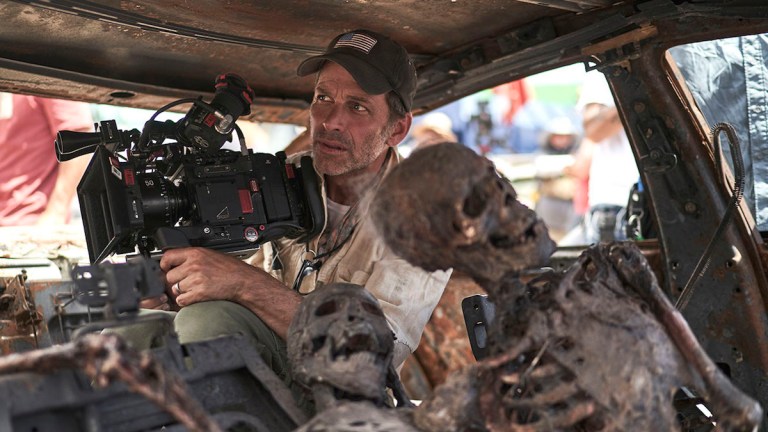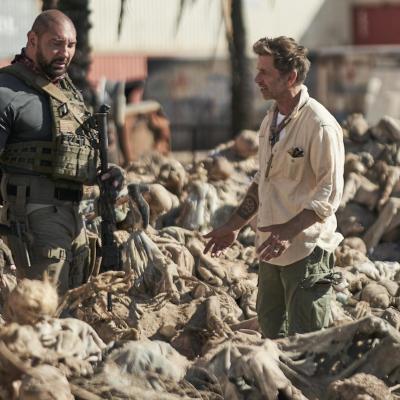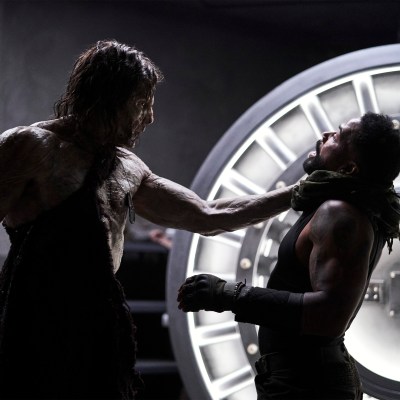Army of the Dead: The Problem with Zack Snyder Song Choices
Army of the Dead follows in the tradition of other Zack Snyder movies by having very noticeable song choices. Is this a good thing?

This article contains Army of the Dead spoilers. Read our spoiler-free review here.
No one has ever accused Zack Snyder of being subtle. As the director who once had Henry Cavill’s Superman and the image of Jesus Christ in red and blue stained glass share the same frame, Snyder’s a filmmaker who likes his subtexts to be written across the screen whenever possible, preferably in neon. It’s an impulse that can lead to sometimes stunning visuals, such as Alan Moore and Dave Gibbons’ Doctor Manhattan filming the moon landing in Watchmen, and it sometimes can be as heavy-handed as Bruce Wayne turning into a literal bat in Batman v Superman: Dawn of Justice.
In other words, Snyder is not one for a light touch when it comes to crafting his visuals… or the music which often accompanies them. And fans who checked out Army of the Dead this past weekend on Netflix were reminded of that latter fact when the director’s penchant for on-the-nose needle drops reached its head-scratching zenith: Snyder ends his zombie movie with the Cranberries’ “Zombie” playing in the background.
As a song written 1994 by Dolores O’Riordan, lead singer of the Cranberries, it seems like an awkward choice for this action-horror hybrid on multiple levels. Considered one of the best alternative rock anthems of the ‘90s, “Zombie” remains among the top tier protest songs of the last 30 years. It was written by an Irish rocker in defiance of then-recent violence implemented by the IRA in the UK, which left two English children dead. Yet here it is in Army of the Dead, playing in a finale where Vanderohe (Omari Hardwick) crawls through the ruins of Las Vegas and the remains of its zombie hordes, with tens of millions of dollars on his back.
For audiences who know the history of the song, it’s jarring; and for those who don’t it is still abrasively trite to have the denouement of their zombie movie conclude to the wails of “Zombie, zombie, zombie!”
But for aficionados of Snyder’s filmography, it’s perfectly in keeping with the filmmaker’s attention-grabbing (and often gaudy) musical choices. Sometimes they can work in favor of his movies and sometimes against—and occasionally in the same scene. No matter what, however, they always make you sit up and take notice.
Admittedly, the use of non-diegetic music in films—needle drops where the music comes over a scene and has no source, such as a radio or live band, on the screen—is subjective. There’s no one set of rules about how to best employ popular music in a movie. With that said, at their best needle drops can either complement or comment on the scene at hand. They can add to the emotion of a movie moment, such as the wistful piano exit of “Layla” playing as the gangsters all get whacked in Goodfellas, or they can challenge the images we see and the story we’re being told, like when Beethoven is used to chilling effect as Malcolm MacDowell’s allegedly refined Alex attacks his friends in A Clockwork Orange.
But at its heart, the good use of a song surprises the audience, often by getting into the emotion or headspace of a character on screen, or illuminating it with some level of abstract distance. Of course the more popular the song is, the more you run the risk of the music carrying baggage for the audience. In period pieces, this can actually be an asset, with each song choice able to evoke a sense of time and place for the audience, particularly if it’s in the audience’s living memory—for example, just about every late 1960s music sample in Once Upon a Time in Hollywood—but it also means filmmakers traditionally want to steer further afield from the most popular Top 40 songs, unless it legitimately comments on a character’s perspective, such as the Crystals’ wildly romantic “Then He Kissed Me” also in Goodfellas.
Snyder doesn’t appear to worry about any of these issues with the song choices in his films. Rather he seems to embrace the cinematic and pop culture baggage of many of his needle drops, wearing them like so much ostentatious jewelry while strutting down the strip. Once in a while they can have the intended effect, such as when he evokes the image of the Vietnam War in the popular imagination by using Wagner’s “Ride of the Valkyries” in Watchmen, reminding audiences of the iconic union of that music with this conflict in Francis Ford Coppola’s Apocalypse Now while also commenting on how Vietnam is a different animal in the alternate history of Watchmen.
In most instances though, it just seems bizarrely under-thought, such as the inexplicable use of “The Sounds of Silence” also in Watchmen. The song is a Simon and Garfunkel standard which was famously written for The Graduate. So, genuinely, what is the point of that song being in Watchmen other than it sounds sad and was written in the ‘60s, and we’re now at the funeral of someone whose heyday was around that time? None of the characters onscreen actually liked the man they’re burying, and the piece just conjures up in the mind a much better movie which used that song with far more haunting nuance.
This drastic give-and-take in quality remains visible in Snyder’s Army of the Dead. Before the groan-inducing use of “Zombie,” Snyder rummages through Hollywood history again when he puts a cover of The Doors’ “The End” over the sequence where his team of casino robbers/zombie killers first enter the ruins of Las Vegas. The version in Army of the Dead is technically sung by The Raveonettes, instead of with Jim Morrison’s nihilistic groove, but it still inescapably conjures up images of Coppola’s Apocalypse Now. Well before Huey helicopters doubled as Valkyries in that movie, Coppola opened the film like an LSD-laced fever dream, with a Vietnam era rock song about the sweet relief found in death.
In Apocalypse Now, the song immediately puts the viewer into the viewpoint of Martin Sheen’s Willard, a war ravaged soldier (or “errand boy”) who even during his time off in a Saigon hotel room cannot stop thinking about the fires of napalm and the whirl of helicopter blades. His vacation is just an impatient waiting game before getting back in the shit. The placement of the slow-motion images with the Doors’ song creates one of the most hypnotic and nihilistic opening sequences of the 1970s—and in a film that has withstood the decades to be considered an enduring classic. So to use that particular song so unironically in Army of the Dead is thus numbing because it appears to be a naked attempt to draw a line between the visual madness of Apocalypse Now with a fairly formulaic zombie movie.
The comparison is unflattering to Army of the Dead, yet it was entirely avoidable. Which makes its use all the more baffling, particularly as Snyder’s movie does have some smart music choices.
In fact, there is one unabashedly great needle drop in Army of the Dead, and as with several Snyder films before it, this occurs during the film’s opening credits. Early on in the Netflix release, we witness the fall of Las Vegas to the undead hordes in montage, experiencing in vignette the horror of seeing Sin City dragged through the mouth of Hell. During this sequence, an ironic use of “Viva Las Vegas” is played. Initially, this would seem to be another lazy choice, as using songs that feature the setting of a city can lead to something as uninspired as, well, just about every other movie that’s featured “Viva Las Vegas” and not starred Elvis Presley and Ann-Margret.
But in the case of Army of the Dead, Snyder makes the savvy choice of having Richard Cheese and Allison Crowe record a new cover of the Presley lounge act specifically for his movie. Cheese, a comedic and kitschy singer who made a career out of doing ironically swinging covers of pop songs or heavy metal anthems, previously appeared in Snyder’s last zombie movie, Dawn of the Dead. In that 2004 remake of the George A. Romero classic, Snyder deliciously used Cheese’s big band version of “Get Down with the Sickness,” a Disturbed head-banger about embracing disease and death. Yet with Cheese’s stylish vocalizations, it sounds downright jaunty over images of human survivors waiting around to die as the zombie horde outside continues to exponentially grow.
By having Cheese, as well as Crowe, offer a strangely more restrained version of Elvis’ goofy love letter to the city of sin, Army of the Dead brings the musical heritage of Vegas to the forefront while also destroying it on screen to a familiar song turned disaffected. It’s a legitimately clever sequence.
Perhaps that’s why the use of “Zombie” at the end of the film is so disappointing. Like characters having orgasms in Watchmen while Leonard Cohen bellows, “Hallelujah,” having the word “zombie” sung over the finale of your zombie apocalypse movie feels cheap and crass.
Of course if you scratch a little deeper at the scene in question, perhaps there is added meaning. After all, the Cranberries’ “Zombie” is an anti-war song about “your tanks, and your guns,” and at the end of Army of the Dead, Hardwick’s Vanderohe just survived the biggest weapon of war of all: a nuclear bomb. Is he perhaps surveying the carnage left by the nuke and thinking to himself, “the horror, the horror?”
Snyder has publicly suggested it might be open to that interpretation. In an interview with Joe.ie, Snyder said, “I did it because it was literally the first song that I had on my playlist when I was writing the script. I would just listen to it and I just felt like because the movie is self-aware and ironic, and it kind of understands what it is—I really love that song because of its politics and importance.”
Snyder may acknowledge the political context (more off-screen than on), but I still don’t think the sequence works in that regard. Vanderohe is a mercenary of war and who has spent the whole film killing zombies. Now a nuclear bomb saved him from being trapped in a city overrun by zombies, while also making him a rich man. His eagerness to reach Mexico City and enjoy his newfound wealth does not suggest some enlightened epiphany by either the character or the film about the danger of militaristic annihilation. Rather it accompanies just another glib “twist” to a horror movie ending where at least one character thinks he’s safe and then—surprise—he’s not. You know, like Snyder’s Dawn of the Dead and pretty much every zombie movie going back to Romero’s Night of the Living Dead original (a film which did have plenty to say about the systemic horrors of the world with its ending).
The anti-war meaning of “Zombie” might add an extra layer to its use in Army of the Dead, but its lyrics about bombs still play as obvious, and thudding. It’s a shallow correlation being drawn by a film that’s too shallow to actually have anything to say on this subject matter, especially with less than 10 minutes of running time left.
Much like Hardwicke’s zombie bite at the end, Army of the Dead’s bad decisions leave permanent scars on the whole.


